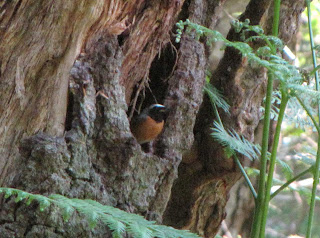Been too busy to post anything this week so two catch-up posts, the first covering avian things and the second (probably tomorrow) covering everything else.
Since the beginning of the month the Wood Warblers have continued to be quiet, elusive and very hard to pin down. I have found a few new nests: 'Goshawk wood nest' had six eggs when found on 1st. The male is a colour ringed bird which bred at Whitemoor (a few km away) last year. 'Wet ditch nest' found on 29th May with 5 eggs had six when checked on 2nd so she was still laying when I found it. The fact that she has 6 eggs shows that this is a first attempt, not a repeat after previous failure, so birds are still arriving. All the other nests checked were ok. This is looking very much like 2011 when predation was almost non-existent at the egg stage, rather than 2012 when they were being hammered from day one.
On 4th I checked on the Whitethroats nest found during the BTO course. It had been predated. Later I found a Chiffchaff nest with ringable young but there were just 3 of them - half what there should be. The next day I checked some other nests from the BTO course and it was rather a tale of woe. The Dunnocks were ok with 3 young ringed but the Chaffinch with eggs had been predated and the Linnet had one dead nestling, the rest presumably predated. Surprisingly, the ridiculously exposed Chiffchaff nest was ok and 4 young were ringed. The vegetation is now growing up around the nest, helping to conceal it so hopefully they will be ok.
Today I finally got back to the Forest to check on the Wood Warbler nests, change nest camera batteries, etc. Crossroads nest, Goshawk wood nest and Larch brash nest were all ok and still had eggs. Crossroads nest had had a close escape though, the nest camera showing a grass snake perilously close to the nest:
Ford nest has now hatched and has 5 young 1-2 days old. What happened to the 6th egg, I don't know. I suspect that these partial losses are due to mice but there is no camera on this nest so I'll never know for sure. Wagtail nest had 4 young just hatching and two eggs which will hopefully still hatch. I then found a new nest 'Bridge nest' which had 6 young about 2 days old. This was a pair that I saw early on in May but not since.
Sneaky nest had also hatched and had 5 young 2-3 days old. I spent a while watching what the adults were feeding to the young; 4 caterpillars, 3 craneflies, 1 moth, 1 unidentified adult insect and 2 unidentified items. As is normal at this age, the male was doing the majority of the provisioning.
I went to check an area that I haven't looked at so far this year. No Wood Warblers but I found my first Redstarts nest of the year. It had 4 young about 8 days old and two infertile eggs (I do find that Redstarts seem to have a high proportion of infertile eggs).
It is often thought that female Redstarts are a bit dull but if the sun catches the tail in the right way, they can be stunning.
Gilbert's brother is visiting the site at the weekend so hopefully there will be some pictures that really do these birds justice!
I then went to check on Fir Twig Tent nest and these had also hatched, with 6 young about 2 days old. They had also had a close shave though:
This is surprising as there are very few squirrels in the Forest at the moment. The size of the young at this stage is shown below.
Finally I found a new nest (Log ditch nest). As I stepped into the ditch, the young hissed at me - always a sign that they are quite old and sure enough these were about 7 days old. Sadly there were only 2 young and 4 infertile eggs. The fact that this pair started a few days before the others makes me wonder if the poor weather at the time is the cause of the poor hatching rate - or perhaps I should spray the insects in the area with Viagra?







No comments:
Post a Comment